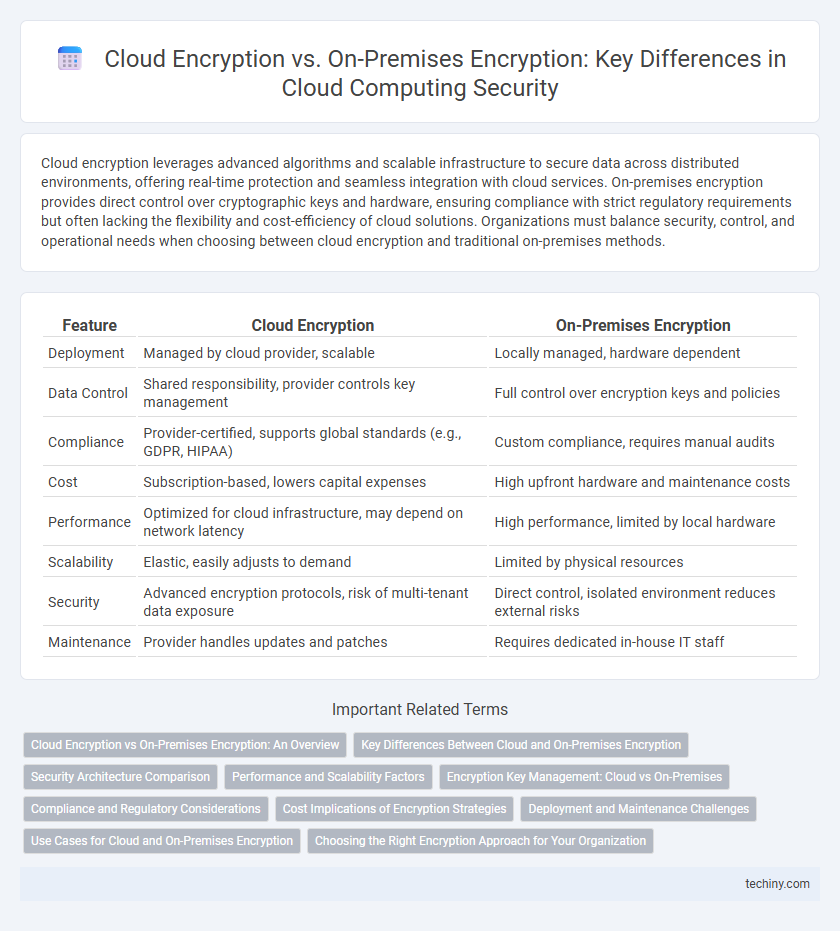Cloud encryption leverages advanced algorithms and scalable infrastructure to secure data across distributed environments, offering real-time protection and seamless integration with cloud services. On-premises encryption provides direct control over cryptographic keys and hardware, ensuring compliance with strict regulatory requirements but often lacking the flexibility and cost-efficiency of cloud solutions. Organizations must balance security, control, and operational needs when choosing between cloud encryption and traditional on-premises methods.
Table of Comparison
| Feature | Cloud Encryption | On-Premises Encryption |
|---|---|---|
| Deployment | Managed by cloud provider, scalable | Locally managed, hardware dependent |
| Data Control | Shared responsibility, provider controls key management | Full control over encryption keys and policies |
| Compliance | Provider-certified, supports global standards (e.g., GDPR, HIPAA) | Custom compliance, requires manual audits |
| Cost | Subscription-based, lowers capital expenses | High upfront hardware and maintenance costs |
| Performance | Optimized for cloud infrastructure, may depend on network latency | High performance, limited by local hardware |
| Scalability | Elastic, easily adjusts to demand | Limited by physical resources |
| Security | Advanced encryption protocols, risk of multi-tenant data exposure | Direct control, isolated environment reduces external risks |
| Maintenance | Provider handles updates and patches | Requires dedicated in-house IT staff |
Cloud Encryption vs On-Premises Encryption: An Overview
Cloud encryption leverages scalable, automated security protocols managed by cloud service providers, ensuring real-time data protection and simplified compliance with regulations such as GDPR and HIPAA. In contrast, on-premises encryption requires organizations to maintain and update their encryption infrastructure, often leading to higher costs and limited scalability. Cloud encryption offers enhanced flexibility and centralized key management, while on-premises solutions provide greater direct control over encryption keys and data access.
Key Differences Between Cloud and On-Premises Encryption
Cloud encryption leverages scalable, vendor-managed key storage and automated key rotation, providing flexibility and reduced administrative overhead compared to on-premises encryption that relies on physical hardware security modules (HSMs) and manual key management. Cloud environments offer integrated encryption with elastic compute resources, enabling seamless data protection across distributed systems, whereas on-premises encryption demands significant capital investment in infrastructure and dedicated security personnel. Latency and control differ, with on-premises encryption offering lower latency and full administrative control, while cloud encryption emphasizes scalability, accessibility, and managed security services.
Security Architecture Comparison
Cloud encryption leverages distributed key management and hardware security modules (HSMs) within multi-tenant environments to provide scalable and resilient data protection. On-premises encryption relies on localized key storage and dedicated hardware, offering greater control but requiring robust physical security and internal policy enforcement. The cloud's security architecture emphasizes automated compliance and threat detection, while on-premises systems depend heavily on manual security protocols and infrastructure maintenance.
Performance and Scalability Factors
Cloud encryption offers superior scalability by leveraging distributed resources, enabling seamless data protection across vast, dynamic environments without performance degradation. On-premises encryption relies heavily on localized hardware, potentially causing bottlenecks when scaling or handling high data volumes, which can impact system responsiveness. The cloud's elastic infrastructure ensures consistent encryption performance even during traffic spikes, whereas on-premises systems may require costly upgrades to maintain similar levels of efficiency.
Encryption Key Management: Cloud vs On-Premises
Encryption key management in cloud computing offers scalable and automated solutions that reduce the burden on IT teams by integrating with centralized cloud security platforms. On-premises encryption key management provides organizations with full control over key storage and lifecycle, enabling strict compliance with regulatory requirements and minimizing exposure to external threats. Cloud platforms leverage hardware security modules (HSMs) and multi-tenant architectures to enhance key protection, while on-premises systems require dedicated physical infrastructure and manual processes to maintain security and availability.
Compliance and Regulatory Considerations
Cloud encryption offers scalable compliance with industry standards such as GDPR, HIPAA, and PCI-DSS by leveraging provider-managed key management systems and encryption protocols tailored for dynamic cloud environments. On-premises encryption allows organizations to maintain complete control over cryptographic keys and data residency, often facilitating adherence to strict regulatory requirements that mandate physical data sovereignty and tighter audit controls. Both approaches require rigorous implementation of encryption algorithms like AES-256 and comprehensive monitoring to ensure compliance with evolving data protection laws and standards.
Cost Implications of Encryption Strategies
Cloud encryption significantly reduces upfront hardware and maintenance costs compared to on-premises encryption, which requires substantial investment in physical infrastructure and dedicated security personnel. Operational expenses in cloud encryption scale with usage, offering flexible and predictable budgeting, whereas on-premises encryption incurs fixed costs regardless of data volume. Encryption key management in cloud environments often benefits from integrated, automated tools that lower administrative overhead, contrasting with the higher labor costs associated with manual key management on-premises.
Deployment and Maintenance Challenges
Cloud encryption offers simplified deployment through automated key management and scalable infrastructure, reducing the need for extensive in-house IT resources. On-premises encryption demands complex setup, continuous hardware updates, and specialized personnel for key storage and security compliance. Maintenance challenges intensify on-premises due to physical hardware vulnerabilities, patch management, and operational overhead, while cloud providers handle these via centralized, real-time security updates.
Use Cases for Cloud and On-Premises Encryption
Cloud encryption excels in dynamic, scalable environments where remote access and multi-tenant security are critical, such as SaaS applications and disaster recovery solutions. On-premises encryption is ideal for organizations with strict regulatory requirements or sensitive data needing full control, including healthcare records and financial transactions. Hybrid scenarios leverage both methods to balance cloud agility with on-site security compliance.
Choosing the Right Encryption Approach for Your Organization
Selecting the right encryption approach depends on factors such as data sensitivity, compliance requirements, and infrastructure capabilities. Cloud encryption offers scalability and seamless integration with cloud services, while on-premises encryption provides greater control and customization. Evaluating risk tolerance, budget, and management resources helps organizations determine the optimal balance between security and operational efficiency.
Cloud Encryption vs On-Premises Encryption Infographic

 techiny.com
techiny.com